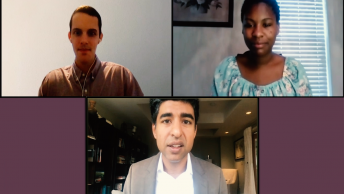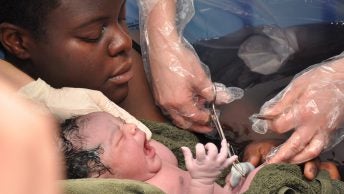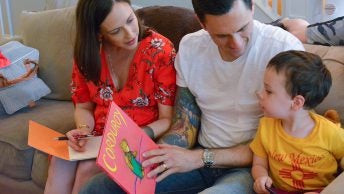By Gwendolyn Wallace
Content warning: police violence
Recently, mainstream media has been paying more attention to and initiating conversations about the dizzying maternal mortality rates for women of color. While it is important to reduce maternal mortality rates, I too often see this care for Black life ending in the delivery room. In April 2019, two officers in Hugo, Oklahoma opened fire on a vehicle driven by a Black robbery suspect outside of a food bank. The officers hit three of the four Black children in the back of the car in the head with bullets. Though the children are all alive, they suffered unimaginable emotional and physical injuries. Today, Black children are more likely to suffer police violence, be suspended or expelled from school, live in poverty, and commit suicide than white children. Black families are not free so long as the joy of parenthood is interlaced with the awareness that their children’s lives are under constant threat.
To understand how to approach a reproductive rights movement that must acknowledge the precarity of Black life, I continually return to the words of Black women who have always understood what is at stake when we talk about our collective future. We have to first confront the question of whose bodies matter within our current hierarchies of domination. We cannot begin to imagine a world where every person has the support they deserve to grow their family if we don’t contend with the harm of capitalism, patriarchy, white supremacy, and settler colonialism.
In June 1994, twelve Black women built on the work of their ancestors to give us the language to generate transformative change for our families and communities. At a national pro-choice conference in Chicago, these women, who were working at the forefront of reproductive rights and health, created the framework of reproductive justice.* In Conceptualizing Reproductive Justice Theory, Loretta Ross, one of the activists who created the framework, writes that the three intersecting values of reproductive justice are, “the right not to have children by using safe birth control, abortion, or abstinence; the right to have children under the conditions we choose; and the right to parent the children we have in safe and healthy environments.” In addition, Ross writes that “reproductive justice demands sexual autonomy and gender freedom for every human being.”
Black women, indigenous women, and trans people have always fought for reproductive justice; the reproductive justice framework utilized these inherited ideas to influence the language used to talk about the reproductive lives of women and birthing people, and put the experiences of the most marginalized women at the center. At the turn of the 21st century, groups of marginalized women were transforming conversations about reproductive rights from a focus on abortion to the greater matrix of intersecting issues that contribute to a person’s decision to grow (or not grow) their family. In 1997, some of the founders of the reproductive justice movement founded SisterSong Women of Color Reproductive Justice Collective, the largest national multi-ethnic reproductive justice group representing organizations from the Native American, Latin American, African American, and Asian American communities.
Today, it is the last tenet of reproductive justice – the right to parent children in safe and sustainable communities – that is the least well discussed. In our devotion to fighting for a world where people can grow their families, we also need to be fighting against the environmental racism and classism which prevents families in Flint, Michigan from getting clean water. We need to be fighting to give indigenous people their land back. We need to be fighting against immigration policies and borders which allow for young children in cages. We need to be fighting to end both state and interpersonal violence against trans and gender non-conforming children and adults. That is what reproductive justice looks like. It is a dynamic way to struggle towards our liberation and the liberation of our children together, in all of our fullness, with all our complex identities and needs.
The reproductive justice movement is not only about pregnancy and birth – it has created crucial space for solidarity and coalition-building between the disability rights, Native American sovereignty, environmental justice, prison abolition, LGBTQ+ rights, and racial justice movements, just to name a few. Expecting more for all of us necessitates that we understand and address the ways that various power systems impact one another, and commit to fighting all abuses of power.
Last semester, I had the opportunity to observe a kindergarten classroom in New Haven, Connecticut. On one Thursday morning, I walked into a small space off to the side of the classroom and was immediately greeted by three students. “Welcome to our restaurant!” They shouted. I glanced at the menu they made and ordered an array of dishes which included donuts, hotdogs, and ice cream. While two of them scrambled to put all the “food” into a bowl, I inquired “How much does it cost?”. “Nothing!” one student said. “Food shouldn’t cost,” she began, “and if you don’t have money, you don’t have to pay anything.” I nodded. She continued, “And if someone has a lot of money, then they don’t pay either, but they give it all away to other people.”
The littlest people among us are already looking around and expecting more from the world we’ve given them. As a Black woman, reproductive justice means urgently fighting for a future that I want to leave my children with, that will give them space to be all that they are, and a world that wants them to survive. Along with our desire to ensure that every birthing person can give birth to a healthy child if they wish to, we simultaneously need to work towards a world where the lives that all children will live when they leave the womb are valued. We must understand that these are the same fights. At its core, reproductive justice theory calls for us to radically imagine the world we want to see. It calls for us to all do our part to create communities where systems of mutual support thrive, which center the margins, and that address unjust distributions of power directly. Our collective liberation and reproductive justice cannot exist without one another. If we believe that freedom is indivisible, we need to not just expect more, but demand everything, and settle for nothing less.
Gwendolyn Wallace (she/her) is a junior at Yale University pursuing a BA in the History of Science and Medicine, concentrating in Gender, Reproduction, and the Body. Her research interests include histories of community health activism, reproductive justice, and the intersections between race, science, and medicine. Gwendolyn enjoys working with young children, cooking, and searching for new bookstores to explore. She lives in Danbury, Connecticut with her family.
*The twelve women who created the reproductive justice framework are: Toni M. Bond Leonard, Reverend Alma Crawford, Evelyn S. Field, Terri James, Bisola Marignay, Cassandra McConnell, Cynthia Newbille, Loretta Ross, Elizabeth Terry, ‘Able’ Mable Thomas, Winnette P. Willis, and Kim Youngblood
Header illustration from the Repeal Hyde Art Project



